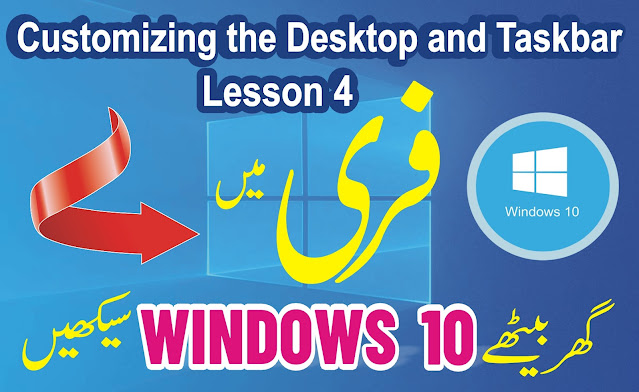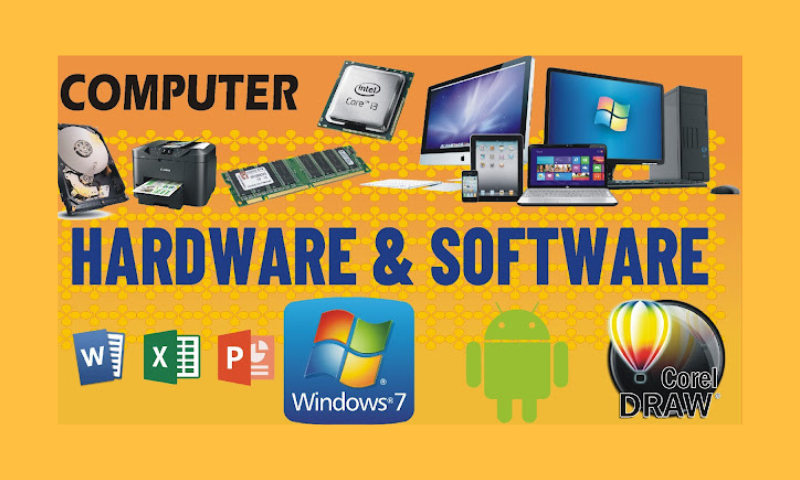Customizing the desktop and taskbar is an important aspect
of making Windows 10 more personalized and productive for the user. In
this Lesson, we will discuss some of the key customization options available
for the desktop and taskbar.
Windows 10 Complete Course (100% Free)
Explore to All Windows 10 Lessons:
You can review our Tips & Tricks of Windows 10 posts in the following windows:
Customize the Desktop
Customizing the desktop in Windows 10 is a great way to make
your computer feel more personalized and organized. There are many different
options available for customizing the desktop, from changing the background to
adding new icons and gadgets. In this section, we will explore some of the key
customization options available for the desktop in Windows 10.
Changing the Background:
The first step in customizing the desktop is to change the
background. To do this, right-click on the desktop and select
“Personalize” from the dropdown menu.
From there, you can choose a
new wallpaper from the available options or browse for a picture of your
choice. You can also choose to use a solid color or a slideshow of multiple
images.
Changing the Wallpaper:
To change the wallpaper, right-click on the desktop and
select “Personalize” from the drop-down menu. Under the
“Background” section, you can choose a new wallpaper from the available
options or browse for a picture of your choice.
Adding and Removing Desktop Icons:
To add a new desktop icon, simply locate the program or file
you want to add and drag it onto the desktop. To remove an icon, right-click on
it and select “Delete.”
You can also choose to hide icons by
right-clicking on the desktop and selecting “View” and then
unchecking the “Show desktop icons” option.
Changing the Desktop Icons:
To change the desktop icons, right-click on the desktop and
select “Personalize” from the drop-down menu. Click on
“Themes” and then click on “Desktop Icon Settings.” From there,
you can choose which icons you want to display on the desktop.
Adding and Removing Desktop Gadgets:
Desktop gadgets are small applications that can be placed on
the desktop to provide quick access to information or tools. To add a new
gadget, right-click on the desktop and select “Gadgets” from the
dropdown menu. From there, you can choose from a variety of available gadgets,
such as weather forecasts or system monitors. To remove a gadget, simply
right-click on it and select “Close.”
Changing Desktop Settings:
To access the desktop settings, right-click on the desktop
and select “Display Settings” from the dropdown menu. From there, you
can adjust settings such as screen resolution, scaling, and orientation.
You can also choose to enable or disable features such as desktop icons and
gadgets.
Organizing the Desktop:
To organize the desktop, you can create folders and move
icons into them. Simply right-click on the desktop and select “New”
and then “Folder.” You can then name the folder and drag and drop
icons into it.
You can also use the “Align icons to grid” option to
automatically organize icons in a grid pattern.
Using Virtual Desktops:
Virtual desktops allow you to create multiple desktops, each
with its own set of apps and windows. To access virtual desktops, click on
the “Task View” button on the taskbar or press the “Windows Key
+ Tab.” From there, you can create a new desktop and switch between them.
Customizing the desktop in Windows 10 is a great way to make
your computer feel more personalized and organized. By following the steps
outlined above, you can easily customize your desktop to suit your needs and
preferences.
Customizing the Taskbar
Customizing the taskbar in Windows 10 can help you improve
your productivity and make it easier to access frequently used programs and
applications. There are several options available for customizing the taskbar
in Windows 10, including changing its position, adding or removing icons, and
enabling or disabling different features. In this section, we will explore some
of the key customization options available for the taskbar in Windows 10.
Right-click the taskbar and choose “Taskbar
Settings” from the drop-down menu to alter it. Here, you can choose to
hide the taskbar in desktop mode, choose which icons are displayed, and even
change the taskbar color and transparency.
Changing the Taskbar Position:
By default, the taskbar is displayed at the bottom of the front
screen. However, you can choose to move it to a different location, such as the
top or sides of the screen. To do this, right-click on the taskbar and select
“Taskbar settings.” From there, you can choose a new position for the
taskbar.
Adding or Removing Taskbar Icons:
To add a new icon to the taskbar, simply locate the program
or file you want to add and drag it onto the taskbar. To remove an icon,
right-click on it and select “Unpin from the taskbar.”
You can also
choose to hide icons by right-clicking on the taskbar and selecting
“Taskbar settings” and then selecting “Turn system icons on or
off.”
Enabling or Disabling Taskbar Features:
Windows 10 comes with several features that can be enabled
or disabled on the taskbar. For example, you can choose to enable or disable
the Cortana search bar, the Task View button, or the People button. To do this,
right-click on the taskbar and select “Taskbar settings.” From there,
you can enable or disable different features as needed.
Customizing Taskbar Notification Area:
The notification area of the taskbar shows icons for system
and program notifications. You can customize which icons appear in this area by
right-clicking on the taskbar and selecting “Taskbar settings.” From
there, you can choose which icons should be shown or hidden in the notification
area.
Customizing the taskbar in Windows 10 can help you make the
most of your computer and improve your productivity. By following the steps outlined
above, you can easily customize your taskbar to suit your needs and
preferences.
Pinning Apps to the Taskbar:
To pin an app to the taskbar, simply right-click on the app
and select “Pin to taskbar.” This will allow you to quickly access
your favorite apps from the taskbar.
Adding Toolbars to the Taskbar:
To add a toolbar to the taskbar, right-click on it and
select “Toolbars” from the drop-down menu. Here, you can choose to
add toolbars such as the Address toolbar, Links toolbar, or Quick Launch
toolbar.
How to customize the date and time in windows 10?
Customizing the date and time in Windows 10 is a simple process
that can help you keep track of your schedule and improve your productivity. By
customizing the date and time, you can change the format, time zone, and other
settings to match your preferences. In this article, we will explore some of
the key customization options available for the date and time in Windows 10.
Changing the Date and Time Format:
To change the format of the date and time, right-click on
the taskbar and select “Adjust date/time.” From there, click on
“Change date and time formats” and choose the desired format for the
date and time. You can also choose to include additional information, such as
the day of the week, in the format.
Changing the Time Zone:
If you travel frequently or work with people in different
time zones, it can be helpful to change the time zone on your computer. To do
this, go to the “Adjust date/time” settings as described above and
click on “Add clocks for different time zones.” From there, you can
add additional time zones and choose which one should be displayed on the
taskbar.
Setting the Time Automatically:
By default, Windows 10 sets the time automatically based on
your location. However, if you prefer to set the time manually, you can disable
this feature by going to the “Adjust date/time” settings and toggling
off the “Set time automatically” option.
Customizing the Date and Time in the Taskbar:
You can customize how the date and time are displayed on the
taskbar by right-clicking on the taskbar and selecting “Taskbar
settings.” From there, you can choose to show or hide the date, and change
the format of the time.
Changing the First Day of the Week:
If you prefer to start your week on a day other than Monday,
you can change the first day of the week by going to the “Adjust
date/time” settings and clicking on “Change calendar settings.”
From there, you can choose which day should be the first day of the week.
Customizing the date and time in Windows 10 can help you
stay organized and on top of your schedule. By following the steps outlined
above, you can easily customize your date and time settings to match your
preferences and needs.
Conclusion
In conclusion, customizing the desktop and taskbar in
Windows 10 is a simple and effective way to personalize your computer
experience. By following the steps outlined in this article, you can easily
change the background image, add or remove icons, and adjust the taskbar
settings to match your preferences. Whether you want to improve your
productivity, make your computer easier to use, or just express your personal
style, customizing the desktop and taskbar in Windows 10 can help you achieve
your goals. So take some time to explore the customization options available in
Windows 10 and create a desktop and taskbar that is uniquely yours.
Windows 10 Complete Course (100% Free)
Explore to All Windows 10 Lessons:

















